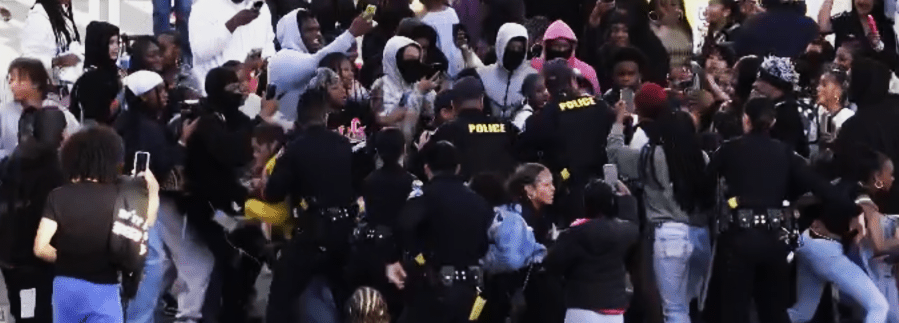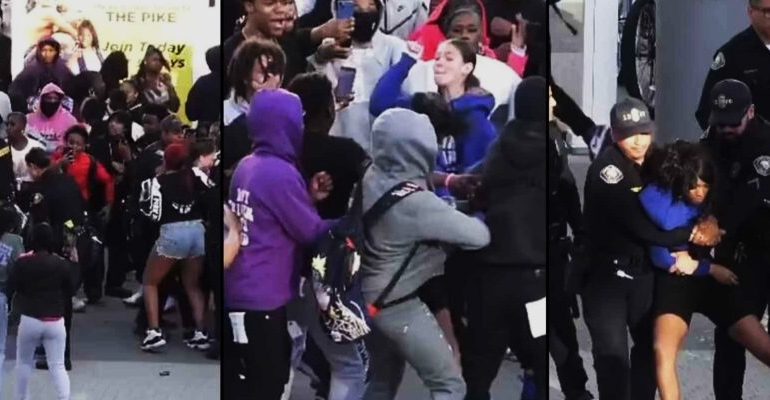In an unprecedented disturbance, a massive youth brawl involving minors erupted at a Southern California mall, prompting an immediate lockdown of the premises. According to reports circulating on social media, approximately 200 individuals converged at the Long Beach shopping center, sparking a significant public safety concern. This incident not only disrupted the peace but also raised questions about the legal repercussions and the broader implications for juvenile behavior in public spaces.
Through this article, we aim to delve into the legal framework surrounding such events in California, exploring the potential legal consequences for the minors involved and examining the state’s approach to handling episodes of public disturbances instigated by youth. Our exploration seeks to shed light on the intersection of juvenile justice and public safety, providing insights into how California’s legal system navigates the complexities of maintaining order while ensuring justice and rehabilitation for younger populations.
Legal Framework for Handling Brawls Involving Minors in California
California’s legal framework provides a comprehensive approach to handling brawls and public disturbances, particularly those involving minors. The state’s laws are designed to balance the need for public safety with the recognition that juveniles have different levels of maturity and decision-making capabilities compared to adults. This section outlines the key legal aspects of managing such incidents.
California Laws Relevant to Brawls and Public Disturbances
- Disorderly Conduct (California Penal Code Section 647): This law encompasses various acts that could disrupt public order, including fighting in a public place. Minors involved in brawls may be charged under this statute.
- Assault and Battery (California Penal Code Sections 240 and 242): Assault is an attempt to violently injure another person, while battery involves actual physical contact. Participants in a brawl could face these charges, depending on their actions.
- Vandalism (California Penal Code Section 594): If a brawl leads to property damage, those responsible could be charged with vandalism, which involves maliciously defacing, damaging, or destroying someone else’s property.
Juvenile vs. Adult Legal Processing
In California, the legal system distinguishes between juveniles (individuals under 18) and adults in processing criminal acts. Minors accused of crimes are typically handled by the juvenile justice system, which focuses more on rehabilitation than punishment. Key differences include:
- Court Proceedings: Juvenile cases are usually adjudicated in juvenile courts, where proceedings are less formal, and records are often sealed to protect the minor’s future.
- Sentencing: Juvenile sentencing aims at rehabilitation and may involve community service, probation, or placement in a juvenile hall rather than incarceration in an adult prison.
- Diversion Programs: In some cases, minors may be eligible for diversion programs that, upon successful completion, can lead to the dismissal of charges.
Potential Charges for Minors Involved in Brawls
Minors involved in brawls at places like malls can face several charges based on their actions during the incident:
- Disorderly Conduct: For engaging in fighting or disruptive behavior in public spaces.
- Assault/Battery: If the altercation involved attempts or acts of physical violence against others.
- Vandalism: For any property damage incurred during the brawl.
Law Enforcement’s Response to the Incident
At the Scene
- Immediate Response: Law enforcement officers would be dispatched to the scene as soon as the brawl was reported. Their primary goals upon arrival would be to assess the situation, secure the area to prevent further escalation, and provide assistance to anyone injured.
- De-escalation: Officers would employ tactics to de-escalate the violence, using non-lethal means where possible to subdue and separate individuals involved in the brawl.
- Evacuation and Lockdown: Depending on the severity and spread of the disturbance, law enforcement might coordinate with mall security to implement a lockdown or partial evacuation to ensure the safety of uninvolved patrons and staff.
Arrests and Detentions
- Detaining Participants: Minors actively participating in the brawl could be detained for questioning and to prevent further disturbances. The decision to detain or arrest would be based on immediate evidence of criminal activity, such as assault or vandalism.
- Juvenile Processing: Detained minors would likely be processed through the juvenile justice system. Depending on the circumstances, they could be released to their parents or guardians with a citation or held for further legal action if the offense warranted it.
Law Enforcement Statements
- Initial Statements: Law enforcement agencies would likely issue initial public statements regarding the incident, focusing on the safety of the public, the response actions taken, and any immediate consequences for those involved.
- Follow-Up Communications: Further statements might detail the investigation’s progress, including any charges filed, and address how law enforcement plans to prevent similar incidents in the future. These communications might also include calls for witnesses or additional information from the public.
- Community Engagement: Law enforcement might engage with community leaders, schools, and families to address the broader issues that led to the brawl, emphasizing collaborative efforts to improve youth safety and prevent recurrences.
Handling and Investigation
After stabilizing the situation, law enforcement would conduct a thorough investigation, gathering surveillance footage, witness statements, and any physical evidence from the scene to identify participants, understand the brawl’s causes, and determine the appropriate legal actions. This investigation would inform the filing of charges and guide discussions on preventive measures to avoid similar incidents.
The incident’s handling, particularly involving minors, would likely be scrutinized by both the public and legal experts, highlighting the challenges law enforcement faces in balancing the need for public safety with the rights and rehabilitation of young individuals.

Legal Consequences and Precedents
When minors are involved in incidents like brawls at public places in California, the legal outcomes can vary widely based on the specifics of each case, including the actions of the individuals involved, their prior legal history, and the presence of any injuries or significant property damage. The juvenile justice system in California focuses on rehabilitation over punishment, aiming to steer young offenders towards more positive futures while still holding them accountable for their actions.
Possible Legal Outcomes for Minors
- Diversion Programs: First-time offenders or those involved in less serious aspects of the brawl might be eligible for diversion programs. These programs often include community service, counseling, or educational courses on conflict resolution, with the goal of correcting behavior without resorting to harsher legal penalties.
- Probation: Minors might be placed on probation, requiring them to meet certain conditions, such as regular check-ins with a probation officer, adherence to curfews, or participation in community service. Probation allows the minor to remain in the community under supervision.
- Detention: For more serious offenses, or if the minor has a history of delinquency, the court may order detention in a juvenile hall or other youth correctional facility. The length of detention can vary and is typically determined by the severity of the offense and the minor’s behavior and progress while detained.
- Restitution and Fines: Courts may order minors to pay restitution to victims for medical bills, property damage, or other losses incurred due to the brawl. Fines might also be imposed as part of the penalty.
- Behavioral and Educational Programs: Participation in specific behavioral or educational programs may be mandated, focusing on anger management, conflict resolution, or other relevant topics to address the underlying issues that contributed to the minor’s involvement in the incident.
Court Processes
The juvenile court process in California is geared towards rehabilitation and generally includes several steps:
- Detention Hearing: To determine if the minor should be held until the adjudication.
- Adjudication Hearing: Similar to a trial, but without a jury, where the judge decides if the minor committed the offense.
- Disposition Hearing: If the minor is found to have committed the offense, this hearing determines the appropriate sentence or rehabilitation measures.
References to Similar Incidents
Looking at past incidents involving brawls or public disturbances by minors can provide context for understanding how the legal system addresses such situations. For example, a notable case might involve a large fight at a different California mall, where the juveniles were diverted to a conflict resolution program, avoiding detention. Comparing such cases can highlight the system’s flexibility and the range of options available to the court, depending on the circumstances.
The emphasis on rehabilitation over punishment in California’s juvenile justice system reflects a broader understanding of the developmental needs of minors and the potential for positive change. However, the system also maintains the capacity to impose stricter penalties when necessary to protect the public and ensure accountability.
Community and Legal System’s Approach to Prevention
The goal is to address the root causes of youth violence and public disturbances, fostering a safer and more supportive environment for young people.
Community Programs and Legal Measures
- Youth Outreach Programs: Many communities have developed outreach programs aimed at engaging minors in positive activities outside of school hours. These programs offer sports, arts, mentorship, and academic support to keep youth engaged and reduce the likelihood of involvement in negative behaviors.
- School-Based Interventions: Schools play a crucial role in violence prevention by implementing anti-bullying campaigns, conflict resolution training, and social-emotional learning curricula. These initiatives help students develop the skills necessary to manage emotions and resolve conflicts peacefully.
- Community Policing Efforts: Law enforcement agencies often participate in community policing, which includes building relationships with community members and youth, offering crime prevention education, and being visible and accessible in the community. This approach aims to create a sense of trust and cooperation between law enforcement and the communities they serve.
- Legal Restrictions on Unsupervised Minors: Some jurisdictions have implemented curfew laws or policies restricting the presence of unsupervised minors in certain public places at specific times. These legal measures aim to reduce the opportunities for youth to engage in disruptive behaviors or become victims of crime.
Expert Opinions and Recommendations
Experts in juvenile justice and youth development often emphasize the importance of a proactive and positive approach to preventing youth violence and disturbances. Recommendations include:
- Early Intervention: Identifying and supporting at-risk youth at an early age can prevent the escalation of disruptive behaviors. Programs that provide family support, counseling, and intervention services are critical in this effort.
- Community Engagement: Encouraging strong community ties and involvement in positive activities can reduce youth violence. This includes promoting community centers, recreational sports leagues, and volunteer opportunities for young people.
- Education and Awareness: Educating minors about the legal consequences of their actions and the impact of violence on victims and communities can foster a greater sense of responsibility and empathy.
- Collaboration Across Sectors: Effective prevention requires collaboration between schools, law enforcement, social services, and community organizations. This coordinated approach ensures that minors receive consistent messages and support across all areas of their lives.
- Addressing Underlying Issues: Experts advocate for addressing the broader social, economic, and family issues that contribute to youth violence. This includes tackling poverty, improving access to mental health services, and supporting families in crisis.
By implementing these community programs, legal measures, and expert recommendations, California aims to create safer environments for minors and reduce the incidence of public disturbances and violence involving youth.
